Table of Contents

17. Forests: Our Lifeline
One evening Boojho entered the park with an elderly person. He introduced him to his friends. Prof Ahmad was a scientist working in the university. The children started playing while Prof Ahmad sat on a bench in the corner. He was tired as he had participated in the golden jubilee celebrations of the town. After a while, the children also came and sat around him. They wanted to know about the celebrations. Prof Ahmad told them that after the cultural programme, the senior people discussed the town’s unemployment problem. A plan was proposed to put up a factory by clearing an area of the forest just outside the town. This would give the increasing population of the town a chance to get jobs. The children were very surprised when Prof Ahmad told them that many people had objected to this idea.
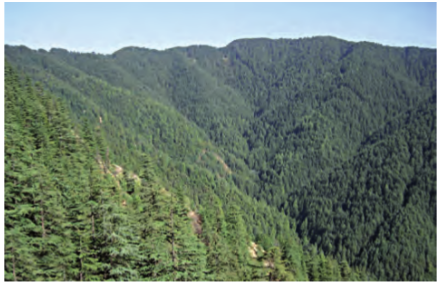
Fig. 17.1 A view of a forest
“This is because the forests serve as green lungs and water purifying systems in nature”, Prof Ahmad explained. The children were confused. Prof Ahmad realised that the children had not visited a forest. The children also wanted to know more about the forest, so they decided to visit it with Prof Ahmad.
17.1 Visit to a Forest
One Sunday morning, the children packed a few things like a knife, a hand lens, a stick, a notebook and walked together through a forest trail near a village. On their way, they met Tibu, a young boy of their age group, of nearby village, who was taking cattle for grazing along with his aunt. He was very agile, running here and there to keep the herd together. When he saw the children, Tibu also started walking along with them, while his aunt went on a different path. As soon as they entered the forest Tibu raised his hand and signalled them to keep quiet because noise could disturb the animals living in the forest.
Tibu then took them to a place at a height to show them the broad view of the forest. Children were surprised because they could not see any land
(Fig. 17.1). The different treetops had formed green cover over the land. However, the cover was not uniformly green. The environment was peaceful and a cool breeze was blowing. This made children quite fresh and happy.
While coming down, they got excited on hearing a sudden sound of birds and some noise from the top branches of the trees. Tibu told them to relax since it was a normal phenomenon here. Because of the children’s presence, some monkeys had climbed higher up on the trees where they disturbed the birds. Animals often give this type of warning call to alert other animals. Tibu also told that many other animals like boar, bison, jackals, porcupine, elephants live in the deeper areas of the forest (Fig. 17.2). Prof Ahmad cautioned children that they should not go deep into the forest.
Boojho and Paheli remembered that they have studied about forests as an example of a habitat in Class VI (Fig. 17.3). They could see now how the forest provides a home for many animals and plants.
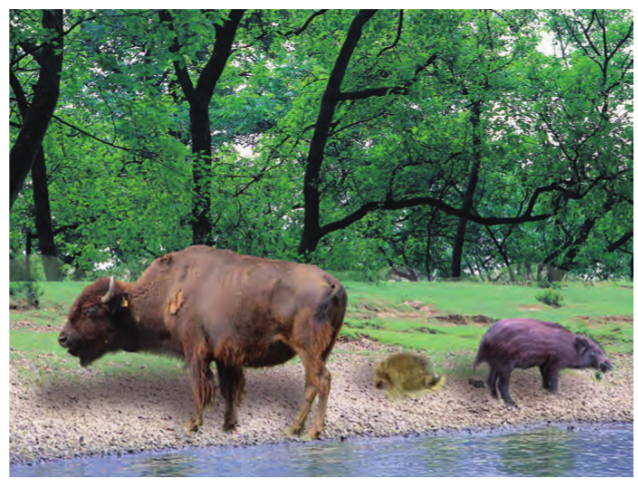
Fig. 17.2 Some forest animals
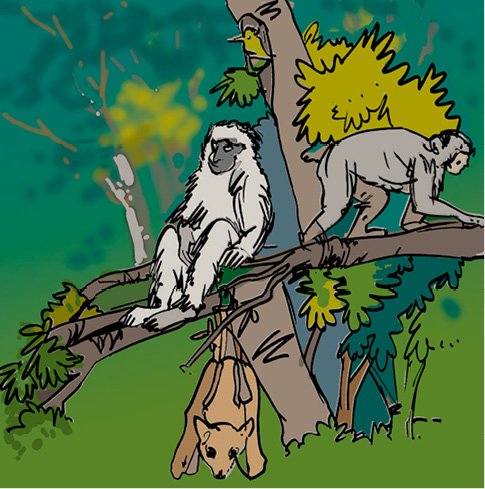
Fig. 17.3 Forest as habitat
The land where the children were walking was uneven and covered with many trees. Tibu helped them to identify sal, teak, semal, sheesham, neem, palash, fig, khair, amla, bamboo, kachnar (Fig. 17.4). Prof Ahmad pointed out that there are several other trees, shrubs, herbs and grasses in the forest. The forest floor and the trees were also covered with different types of creepers and climbers. The sun was barely visible through the leaves of the trees, making it quite dark inside the forest.
Activity 17.1
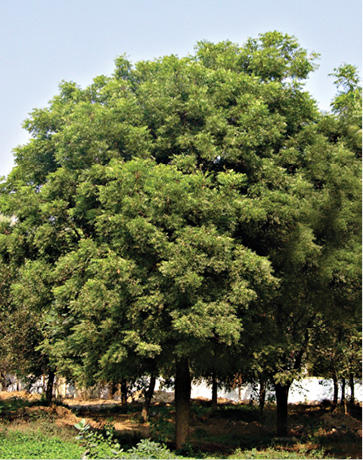
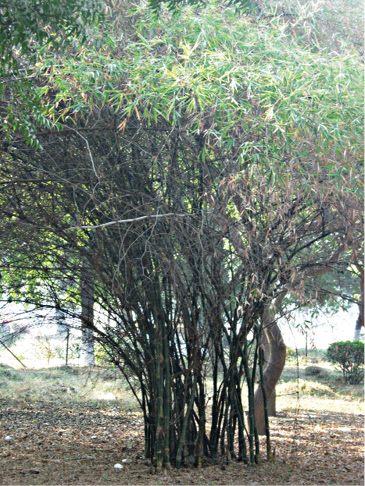
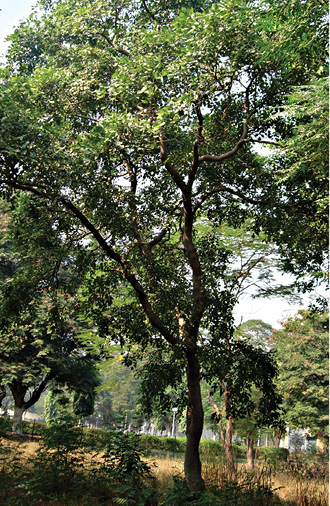
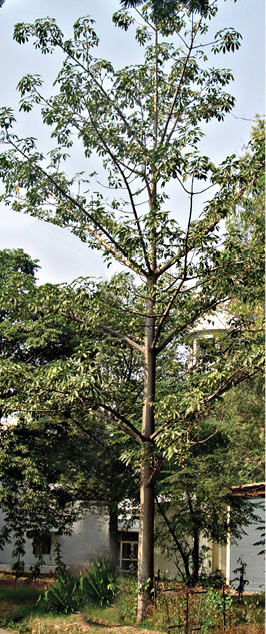
Neem Bambooo Sheesham Semal
Fig. 17.4 Some forest plants
You might have many wooden items on your list like plywood, fuel wood, boxes, paper, matchsticks, and furniture. Do you know that gum, oils, spices, fodder for animals and medicinal plants are also some of the products which we get from the forest (Fig. 17.5).
Based on the products that we get from plants, try to fill Table 17.1. One example of each plant is already given. Fill the table by adding more examples.
Sheila wondered who would have planted these trees. Prof Ahmad replied that in nature trees produce enough seeds. The forest floor provides favourable conditions for them to germinate and develop into seedlings and saplings. Some grow up into trees. He added that branchy part of a tree above the stem is known as the crown of the tree (Fig. 17.6).
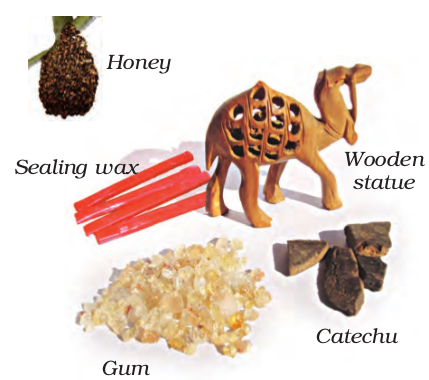
Fig. 17.5 Forest products
Prof Ahmad asked children to look up and observe how the branches of the tall trees look like a roof over the other plants in the forest. He told them that this is called a canopy (Fig. 17.7).
Activity 17.2
Visit a forest or a park in your neighbourhood. Observe the trees and try to identify them. You can take the help of some elders or books on trees. List the characteristics of the trees that you observe, such as the height, shape of leaves, crown, flowers, and fruits. Also draw the crowns of some trees.
Prof Ahmad pointed out that trees had crowns of different types and sizes. These had created different horizontal layers in the forest. These are known as understoreys (Fig. 17.7). Giant and tall trees constituted the top layer followed by shrubs and tall grasses, and herbs formed the lowest layer.

Fig. 17.6 Some crown shapes
| Gum | Timber | Medicinal | Oil |
| Babool | Sheesham | Neem | Sandalwood |

Fig. 17.7 Canopy and under storeys in a forest
A few children were busy watching beautiful butterflies fluttering here and there on the flowers of shrubs and herbs. They had a close look at the bushes. While doing that their hair and clothes had seeds and thorns clinging to them.
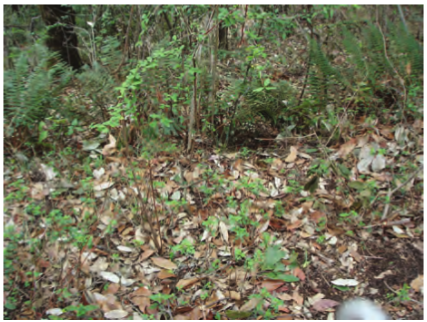
Fig. 17.8 Forest floor
They came across numerous insects, spiders, squirrels, ants and various other small animals on the bark of the trees, plant leaves and on decaying leaves on the forest floor (Fig. 17.8). They started making sketches of these creatures. The forest floor seemed dark coloured and was covered with a layer of dead and decaying leaves, fruits, seeds, twigs and small herbs. The decaying matter was moist and warm.
Is the decaying matter always warm? Prof Ahmad suggested that the children could perform an activity to get an answer to this question.
Activity 17.3
Dig a small pit. Put vegetable waste and leaves in it. Cover them with soil. Add some water. After three days, remove the upper layer of the soil. Does the pit feel warm inside?
Paheli asked, “There are so many trees here. Also, there are many forest like this. What difference will it make if we cut some trees for a factory?”
Prof Ahmad said, “You have read about autotrophs, heterotrophs and saprotrophs. You have learnt how green plants produce food. All animals, whether herbivores or carnivores, depend ultimately on plants for food. Organisms which feed on plants often get eaten by other organisms, and so on. For example, grass is eaten by insects, which in turn, is taken by the frog. The frog is consumed by snakes. This is said to form a food chain:
Grass→ insects→ frog→ snake→ eagle. Many food chains can be found in the forest. All food chains are linked. If any one food chain is disturbed, it affects other food chains. Every part of the forest is dependent on the other parts. If we remove one component, say trees, all other components would be affected.”
Prof Ahmad asked children to pick up leaves from the forest floor and observe them under a hand lens. They found tiny mushrooms over the decaying leaves. They also saw an army of tiny insects, millipedes, ants and beetle on them. They were wondering how these organisms live there. Prof Ahmad explained that apart from these animals which are easily seen, there are several organisms and micro-organisms that live in the soil. Paheli wondered what mushroom and other micro-organisms eat. Prof Ahmad replied that they feed upon the dead plant and animal tissues and convert them into a dark coloured substance called humus.
You have learnt about humus in Chapter 9. In which layer of the soil would you find humus? What is its importance to the soil?
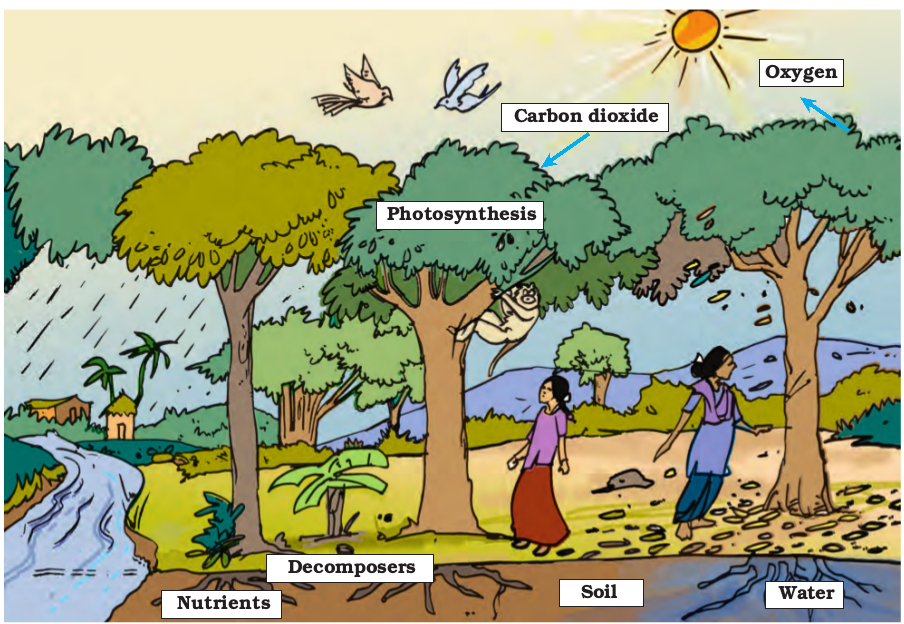
Fig. 17.9 Interrelationship of plant, soil and decomposers in a forest
The micro-organisms which convert the dead plants and animals to humus are known as decomposers. These micro-organisms play an important role in the forest. Soon, Paheli removed some dead leaves and discovered under them a layer of humus on forest floor. The presence of humus ensures that the nutrients of the dead plants and animals are released into the soil. From there, these nutrients are again absorbed by the roots of the living plants. “What happens if an animal dies in the forest?” Sheila asked. Tibu replied the dead animals become food for vultures, crows, jackals and insects.” In this way, the nutrients are cycled. So, nothing goes waste in a forest (Fig. 17.9).
Paheli reminded Prof Ahmad that he had not explained why forests are called green lungs. Prof Ahmad explained that plants release oxygen through the process of photosynthesis. The plants help to provide oxygen for animal respiration. They also maintain the balance of oxygen and carbon dioxide in the atmosphere (Fig. 17.10). That is why forests are called lungs.

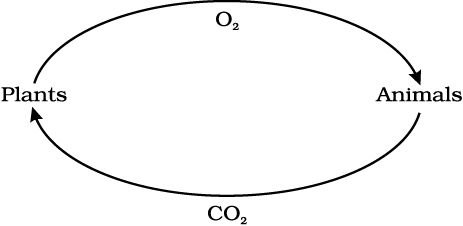
Fig. 17.10 Balance of oxygen and carbon dioxide
The children saw clouds forming in the sky. Boojho recalled what he had learnt about the water cycle in Class VI. Trees take in water from their roots and release water vapour into the air through evaporation.
If there were fewer trees, how will the water cycle be affected?
Tibu told them that the forest is not just home to plants and animals. Many people also live in the forest. Some of them may belong to different tribes. Tibu explained that these people depend mostly on the forests. The forest provides them with food, shelter, water and medicines. They have traditional knowledge about many medicinal plants in the forest.
While Boojho was drinking water from a small stream, he saw some deer crossing the stream (Fig. 17.11). They disappeared into the bushes. The dense bushes and the tall grass provide animals with the food and shelter. They also protect them from carnivores that live in the forest.
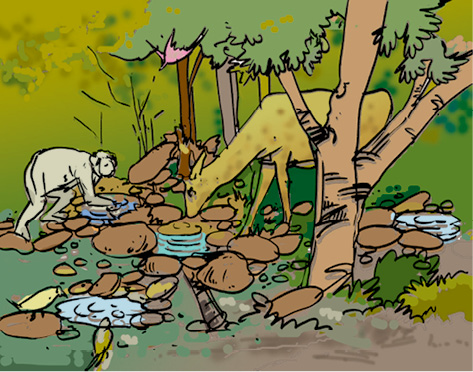

Tibu then started looking closely at the forest floor. Soon he called and showed the children droppings of some animals, and explained the difference between various types of droppings.
Prof Ahmad informed them that the forest officers could recognise the presence of some animals in the forest by their droppings and footprints.
Boojho called every one and showed them a large, decaying heap of animal dropping. Several beetles and grubs were feeding on the heap and a bunch of seedlings was sprouting. “These seedlings are of the herbs and shrubs. The animals also disperse the seeds of certain plants and help the forest to grow and regenerate. The decaying animal dung also provides nutrients to the seedlings to grow”, said Prof Ahmad.
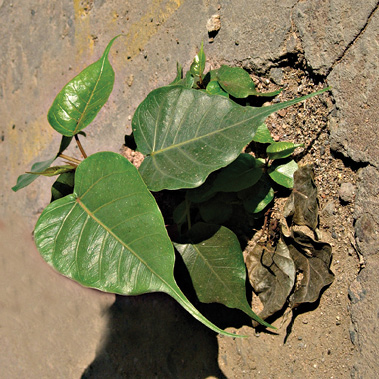
After listening to this, Boojho noted in his notebook, “By harbouring greater variety of plants, the forest provides greater opportunities for food and habitat for the herbivores. Larger number of herbivores means increased availability of food for a variety of carnivores. The wide variety of animals helps the forest to regenerate and grow. Decomposers help in maintaining the supply of nutrients to the growing plants in the forest. Therefore, the forest is a ‘dynamic living entity’ — full of life and vitality.”
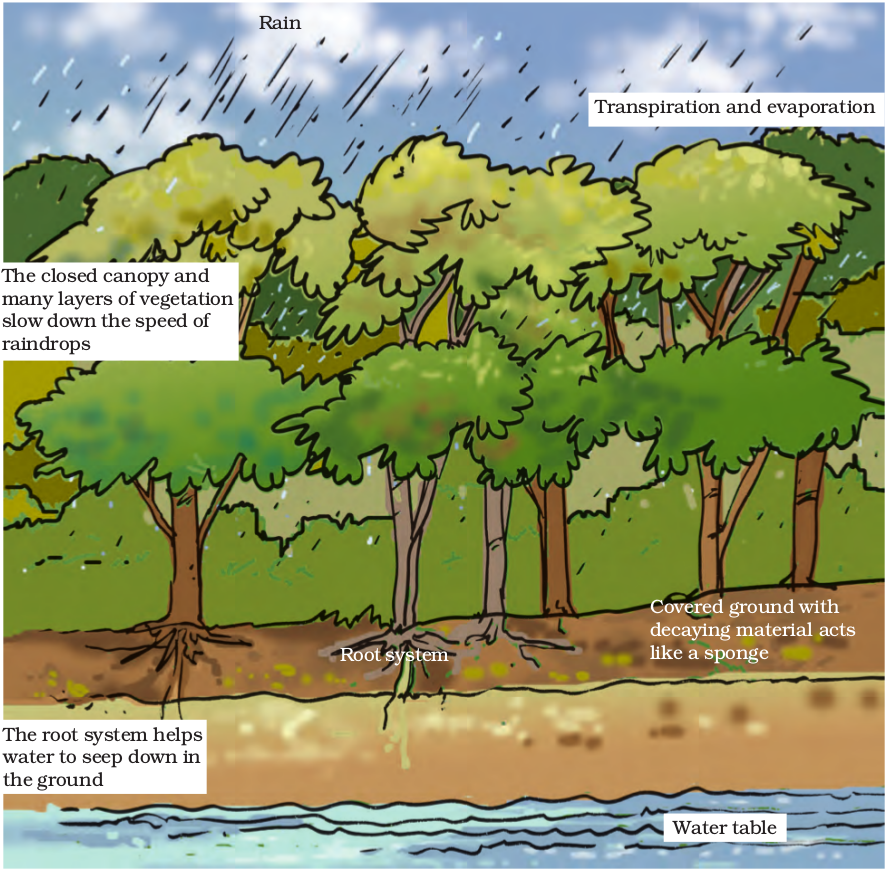
Fig. 17.13 Rainwater drips from the trees and seeps into the ground
It was about afternoon and the children wanted to go back. Tibu suggested another route for going back. While they were going back, it started raining. However, surprisingly, they saw that the raindrops were not hitting the forest floor directly. The uppermost layer of the forest canopy intercepted the flow of raindrops, and most of the water was coming down through the branches and the stems of the trees. From the leaves it was dripping slowly over branches of the shrubs and herbs (Fig. 17.13). They found that the ground was still dry. After about half an hour, the rain stopped. They noticed that the layer of dead leaves over the forest floor appeared wet now. But water did not stagnate in the forest.
Boojho thought that if it had rained so heavily in his town, it would have flooded the drains and roads.
What would happen if it rains heavily in your town?
Prof Ahmad told them that the forest also acts as a natural absorber of rainwater and allows it to seep. It helps maintain the water table throughout the year. Forests not only help in controlling floods but also help maintain the flow of water in the streams so that we get a steady supply of water. On the other hand, if trees are not present, rain hits the ground directly and may flood the area around it. Heavy rain may also damages the soil. Roots of trees normally bind the soil together, but in their absence the soil is washed away or eroded.
The children spent an hour at Tibu’s village on their way back. The weather of the village was quite pleasant. Villagers told them that due to the surrounding forest, they receive good rainfall. The air also remained cool. Noise pollution, too is less because the forest absorbs the noise of the nearby highway.
The children learnt about the history of the village. It surprised them that the villages and the agricultural fields of that area were created after clearing the forest about sixty years ago. Tibu’s grandfather told them that when he was young, the village was not as large as it was now. It was also surrounded
by forests. Construction of roads, buildings, industrial development and increasing demand of wood created pressure on the forests and it started vanishing. He was not happy that the forest adjoining their village is not regenerating and is on the verge of disappearing due to overgrazing of animals and indiscriminate felling of trees. Prof Ahmad said that if we did things wisely we could preserve forests and environment as well as have development.
At the end of the visit, Prof Ahmad asked children to sum up the importance of forests. The children wrote: Forests provide us with oxygen. They protect soil and provide habitat to a large number of animals. Forests
help in bringing good rainfall in neighbouring areas. They are a source of medicinal plants, timber and many other useful products. We must preserve our forests.
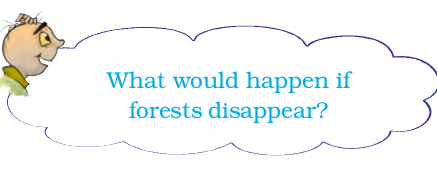
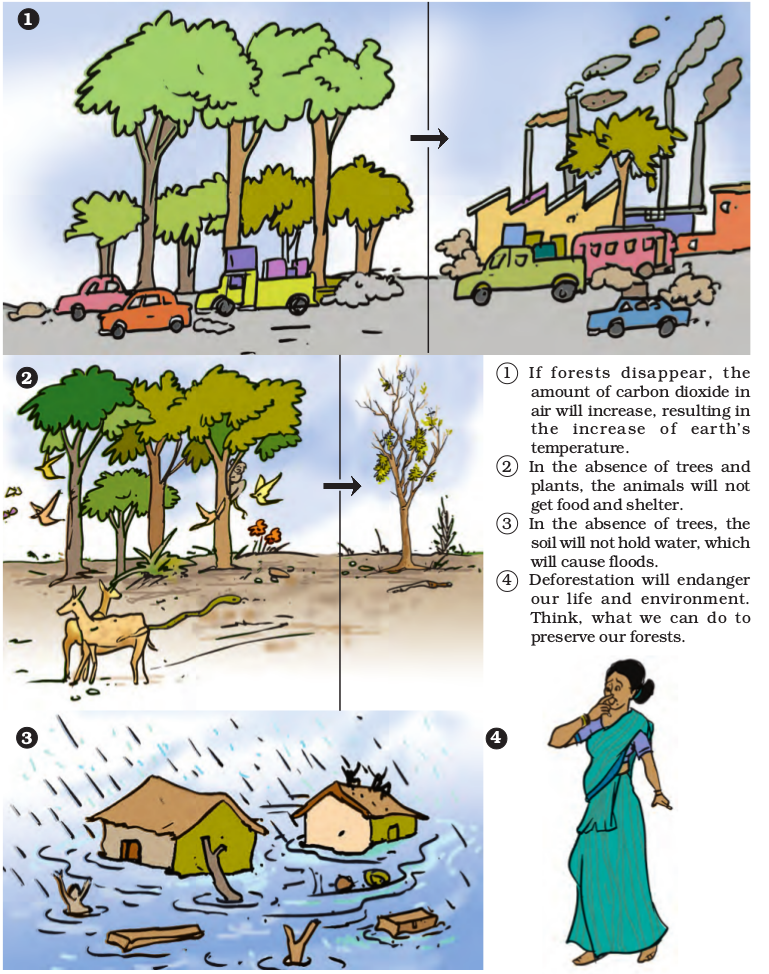
| What you have learnt |
|
Exercises
1. Explain how animals dwelling in the forest help it grow and regenerate.
2. Explain how forests prevent floods.
3. What are decomposers? Name any two of them. What do they do in the forest?
4. Explain the role of forest in maintaining the balance between oxygen and carbon dioxide in the atmosphere.
5. Explain why there is no waste in a forest.
6. List five products we get from forests?
7. Fill in the blanks:
(a) The insects, butterflies, honeybees and birds help flowering plants in .
(b) A forest is a purifier of and .
(c) Herbs form the layer in the forest.
(d) The decaying leaves and animal droppings in a forest enrich the .
8. Why should we worry about the conditions and issues related to forests far from us?
9. Explain why there is a need of variety of animals and plants in a forest.
10. In Fig. 17.15, the artist has forgotten to put the labels and directions on the arrows. Mark the directions on the arrows and label the diagram using the following labels:
clouds, rain, atmosphere, carbon dioxide, oxygen, plants, animals, soil, roots, water table.
11. Which of the following is not a forest product?
(i) Gum
(ii) Plywood
(iii) Sealing wax
( iv) Kerosene
12. Which of the following
statements is not correct?
(i) Forests protect the soil from erosion.
(iii) Forests influence the climate and water cycle.
(iv) Soil helps forests to grow and regenerate.
13. Micro-organisms act upon the dead plants to produce
(i) sand (ii) mushrooms (iii) humus (iv) wood
Extended Learning — Activities and Projects
1. The Department of Environment is to decide whether some portion of a forest in your area could be cleared for a housing complex. Write a letter to the department explaining your point of view as a concerned citizen.
2. Visit a forest. Here is a list of points that would make your visit more fruitful.
(a) Make sure that you have permission to go into the forest.
(b) Make sure that you can find your way around. Get a map and go along with some one who is familiar with the area.
(c) Keep a record of the things you see and do. Observations make the visit interesting. Sketches and photographs are useful.
(d) You may record bird calls.
(e) Collect different kinds of seeds or hard fruits like nuts.
(f) Try to recognise various types of trees, shrubs, herbs, etc. Make lists of plants from different places in the forest and of different layers. You may not be able to name all the plants, but it is worth recording and seeing where they grow. Make a record of
approximate heights of plants, crown shape, bark texture, leaf size, and flower colour.
(g) Learn to recognise the animal’s droppings.
(h) Interview the forest officials and the people of surrounding vil lages and other visitors.
You must never collect birds’ eggs, and their nests should never be disturbed.
You can read more on the following website: www.wild-india.com
| Did you know? |
In India the area under forest cover is about 21% of the total area. It had steadily been falling since independence. But people now seem to have realised the importance of the forest cover. Reports suggest that the area under forest cover has slightly increased in recent years. |